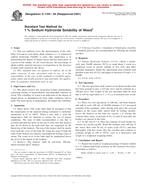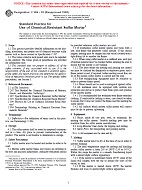1.1 This test method is intended to describe a procedure for testing the effectiveness of a disinfection process for reprocessing reusable medical devices when it is tested with a challenge of vegetative cells including mycobacteria. Disinfection normally deals with testing activity against vegetative cells of bacteria, viruses, and fungi. Since this test method is process oriented, the user may wish to examine a variety of test organisms.
1.2 This test method is designed to provide a reproducible procedure to verify the effectiveness of a previously validated disinfectant or disinfection procedure for reusable medical instruments and devices.
1.3 This test method is not meant to define the effectiveness of or validation of the particular disinfection process used or its kinetics, but rather, it is devised to confirm the effectiveness of the disinfection process by simulating use situations with a particular test process using medical devices and instruments. Either manual or machine reprocessing can be tested.
1.4 This test method is intended for use with reusable cleaned and previously sterilized or disinfected (high level) medical instruments and devices. Endoscopes are described in this test method as a worst-case example for contamination and sampling. The selected sterilization or disinfection processes, or both, should have been validated previously, as well as the effectiveness of rinsing for residual sterilant/disinfectant removal determined.
1.5 An inoculum with high numbers of selected microorganisms is applied to both test and control, cleaned and sterilized, or disinfected medical instruments. Strains of microorganisms with a recorded resistance to disinfectants are used to contaminate the instrument sites known or suspected to be the most difficult to reprocess.
1.6 It is impractical to test for recovery of survivors by immersion of some instruments, for example, endoscopes or some laproscopic instruments, in growth medium because of complexity, size, difficulty in long-term incubation, or deterious effects resulting from incubation. Elution of organisms from the inoculated surfaces, therefore, may be performed to estimate the number of recoverable organisms. Immersion can be used for smaller instruments.
1.7 Control instruments are inoculated in the same manner as the test instruments and elution or immersion methods are performed to determine the number of organisms recoverable from the instrument. For channeled devices, such as endoscopes testing, the number of organisms recoverable from the instrument (inside and outside) will serve as the initial control count. It is expected that some fraction of the number of organisms inoculated will be lost in the process of inoculation/drying.
1.8 A testing procedure can be performed on a complete reprocessing cycle or can be limited to just the cleaning or disinfection portions of the cycle whether reprocessing is done in a machine or manually.
1.9 After the test cycle has been completed, remaining inoculated bacteria will be recovered from test instruments using the same elution procedures as for the control instruments.
1.10 Efficacy of a disinfection cycle or reprocessing cycle, or any part thereof, may be determined by comparison of the number of microorganisms recovered from the control instrument (initial recoverable control count) to the recovery determined for the test instruments.
1.11 A knowledge of microbiological techniques is required to conduct these procedures.
1.12 This standard does not purport to address all of the safety concerns, if any, associated with its use. It is the responsibility of the user of this standard to establish appropriate safety and health practices and determine the applicability of regulatory limitations prior to use.
Product Details
- Published:
- 10/10/2002
- Number of Pages:
- 5
- File Size:
- 1 file , 51 KB


